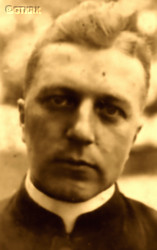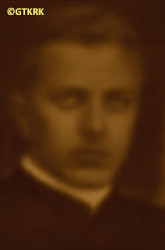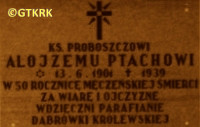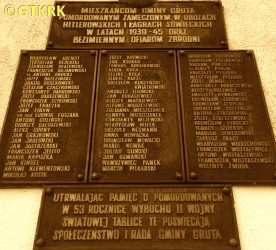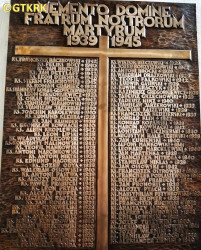Roman Catholic
St Sigismund parish
05-507 Słomczyn
85 Wiślana Str.
Konstancin deanery
Warsaw archdiocese, Poland
full list:
displayClick to display full list

searchClick to search full list by categories
wyświetlKliknij by wyświetlić pełną listę po polsku

szukajKliknij by przeszukać listę wg kategorii po polsku

Martyrology of the clergy — Poland
XX century (1914 – 1989)
personal data
surname
PTACH
forename(s)
Louis Paul (pl. Alojzy Paweł)
function
diocesan priest
creed
Latin (Roman Catholic) Church RCmore on
en.wikipedia.org
[access: 2014.09.21]
diocese / province
Culm (Chełmno) diocesemore on
pl.wikipedia.org
[access: 2012.11.23]
date and place
of death
11.11.1939

Grudziądztoday: Grudziądz city pov., Kuyavia‐Pomerania voiv., Poland
more on
en.wikipedia.org
[access: 2021.09.02]
alt. dates and places
of death
11.1939
Klamrytoday: Chełmno gm., Chełmno pov., Kuyavia‐Pomerania voiv., Poland
more on
en.wikipedia.org
[access: 2021.12.18]
details of death
After German and Russian invasion of Poland in 09.1939 and start of the World War II, after start of the German occupation, arrested on 20.09.1939 by the Germans.
Jailed in VSH Graudenz custody in Grudziądz.
From there taken to an execution site — possibly to so‐called Priests' Hills or the Citadel within Fortress Grudziądz — and murdered.
alt. details of death
According to some sources arrested by the Germans during mass arrests of Polish priests from Łasin deanery — with Fr Leo Gregorkiewicz, Fr John Martenka, Fr Stanislav Niklas, Fr Anastasius Sadowski, Fr Francis Wilczewski, among others.
Jailed in Grudziądz prison (prob. in Kresy–Borderlands Hostel building).
Next prob. on 15.11.1939 moved to Chełmno prison.
Finally taken to Klamry (5 km off Chełmno) and murdered in a mass execution.
cause of death
mass murder
perpetrators
Germans
sites and events
Grudziądz‐FortressClick to display the description, KlamryClick to display the description, VSH CulmClick to display the description, VSH GraudenzClick to display the description, «Intelligenzaktion»Click to display the description, Reichsgau Danzig‐WestpreußenClick to display the description, Ribbentrop‐MolotovClick to display the description, Pius XI's encyclicalsClick to display the description
date and place
of birth
13.06.1901

Miszewotoday: Żukowo gm., Kartuzy pov., Pomerania voiv., Poland
more on
en.wikipedia.org
[access: 2022.01.28]
parents
PTACH Anthony
🞲 ?, ? — 🕆 ?, ?

WANDTKE Martha
🞲 ?, ? — 🕆 ?, ?
presbyter (holy orders)
ordination
13.12.1925

Pelplintoday: Pelplin gm., Tczew pov., Pomerania voiv., Poland
more on
en.wikipedia.org
[access: 2021.05.06]
St Barbara RC chapelmore on
pl.wikipedia.org
[access: 2021.12.19] (in Theological Seminary)
positions held
1937 – 1939
parish priest — Dąbrówka Królewskatoday: Gruta gm., Grudziądz pov., Kuyavia‐Pomerania voiv., Poland
more on
en.wikipedia.org
[access: 2021.12.18] ⋄ St James the Apostle RC parish ⋄ Grudziądz / Łasindeanery names/seats
today: Kuyavia‐Pomerania voiv., Poland RC deanery
1935 – 1937
curatus/rector/expositus — Dąbrówka Królewskatoday: Gruta gm., Grudziądz pov., Kuyavia‐Pomerania voiv., Poland
more on
en.wikipedia.org
[access: 2021.12.18] ⋄ St James the Apostle RC church ⋄ Rogóźnotoday: Rogóźno gm., Grudziądz pov., Pomerania voiv., Poland
more on
en.wikipedia.org
[access: 2021.09.02], St Adalbert the Bishop and Martyr RC parish ⋄ Grudziądz / Łasindeanery names/seats
today: Kuyavia‐Pomerania voiv., Poland RC deanery
1934 – 1935
vicar — Świekatowotoday: Świekatowo gm., Świecie pov., Kuyavia‐Pomerania voiv., Poland
more on
en.wikipedia.org
[access: 2021.09.02] ⋄ St Martin the Bishop and Confessor RC parish ⋄ Świecietoday: Świecie gm., Świecie pov., Kuyavia‐Pomerania voiv., Poland
more on
en.wikipedia.org
[access: 2021.09.02] RC deanery
1932 – 1934
vicar — Chmielnotoday: Chmielno gm., Kartuzy pov., Pomerania voiv., Poland
more on
en.wikipedia.org
[access: 2021.09.02] ⋄ St Peter and St Paul the Apostles RC parish ⋄ Kartuzytoday: Kartuzy gm., Kartuzy pov., Pomerania voiv., Poland
more on
en.wikipedia.org
[access: 2021.09.02] RC deanery
1931 – 1932
vicar — Brusytoday: Brusy gm., Chojnice pov., Pomerania voiv., Poland
more on
en.wikipedia.org
[access: 2021.09.02] ⋄ All the Saints RC parish ⋄ Chojnicetoday: Chojnice urban gm., Chojnice pov., Pomerania voiv., Poland
more on
en.wikipedia.org
[access: 2021.09.02] RC deanery
1929 – 1931
vicar — Kowalewotoday: Kowalewo Pomorskie, Kowalewo Pomorskie gm., Golub‐Dobrzyń pov., Kuyavia‐Pomerania voiv., Poland
more on
en.wikipedia.org
[access: 2021.12.19] ⋄ St Nicholas the Bishop and Confessor RC parish ⋄ Golubtoday: district of Golub‐Dobrzyń, Golub‐Dobrzyń gm., Golub‐Dobrzyń pov., Kuyavia‐Pomerania voiv., Poland
more on
en.wikipedia.org
[access: 2021.09.02] RC deanery
1929
vicar — Strzepcztoday: Linia gm., Wejherowo pov., Pomerania voiv., Poland
more on
en.wikipedia.org
[access: 2021.09.02] ⋄ St Mary Magdalene RC parish ⋄ Wejherowotoday: Wejherowo gm., Wejherowo pov., Pomerania voiv., Poland
more on
en.wikipedia.org
[access: 2021.09.02] RC deanery
1926 – 1929
vicar — Nowa Cerkiewtoday: Morzeszczyn gm., Tczew pov., Pomerania voiv., Poland
more on
en.wikipedia.org
[access: 2021.09.02] ⋄ Assumption of the Blessed Virgin Mary and St Peter and St Paul the Apostles RC parish ⋄ Gniewtoday: Gniew gm., Tczew pov., Pomerania voiv., Poland
more on
en.wikipedia.org
[access: 2021.07.29] RC deanery
1925 – 1926
vicar — Osietoday: Osie gm., Świecie pov., Kuyavia‐Pomerania voiv., Poland
more on
en.wikipedia.org
[access: 2021.09.02] ⋄ Exaltation of the Holy Cross RC parish ⋄ Świecie / Czerskdeanery names/seats
today: Kuyavia‐Pomerania voiv., Poland RC deanery
vicar — Starogard Gdańskitoday: Starogard Gdański gm., Starogard Gdański pov., Pomerania voiv., Poland
more on
en.wikipedia.org
[access: 2021.06.07] ⋄ St Matthew the Apostle RC parish ⋄ Starogard Gdańskitoday: Starogard Gdański gm., Starogard Gdański pov., Pomerania voiv., Poland
more on
en.wikipedia.org
[access: 2021.06.07] RC deanery
1921 – 1925
student — Pelplintoday: Pelplin gm., Tczew pov., Pomerania voiv., Poland
more on
en.wikipedia.org
[access: 2021.05.06] ⋄ philosophy and theology, Theological Seminary
pupil — Wejherowotoday: Wejherowo gm., Wejherowo pov., Pomerania voiv., Poland
more on
en.wikipedia.org
[access: 2021.09.02] ⋄ State Gymnasium for Men — studies crowned on 25.06.1921 with the maturity diploma (i.e. matura)
others related
in death
BIELEŃClick to display biography Anthony, BOJUŁKAClick to display biography Bronislav Francis, GOŁĘBIEWSKIClick to display biography Joseph Lawrence, KLUNDERClick to display biography John, PASTWAClick to display biography Anthony, SOBISZClick to display biography Anthony, GREGORKIEWICZClick to display biography Leo, MARTENKAClick to display biography John, NIKLASClick to display biography Stanislav, SADOWSKIClick to display biography Anastasius, WILCZEWSKIClick to display biography Francis Joseph, BATKOClick to display biography Alexander, BORZYSZKOWSKIClick to display biography Joseph, BROCKIClick to display biography Anthony, BUSZTAClick to display biography Anthony (Fr Simon), CZUBEKClick to display biography Joseph, FLACZYŃSKIClick to display biography Francis, GASIŃSKIClick to display biography Louis, GRABOWSKIClick to display biography Sigismund, HINZClick to display biography Thaddeus, KACZOROWSKIClick to display biography Michael, KĘDZIERSKIClick to display biography Francis, KOPAŃSKIClick to display biography Conrad, KOWNACKIClick to display biography Martin Stanislav, ŁĘGOWSKIClick to display biography Vladislav Leonard, ŁUBIEŃSKIClick to display biography John Boleslav, MAKOWSKIClick to display biography Paul (Fr Bruno), MALINOWSKIClick to display biography Constantine Peter, MAŃKOWSKIClick to display biography Alphonse, MATEUSZCZYKClick to display biography Theodore, MIĘTKIClick to display biography Anthony, NAGÓRSKIClick to display biography Edmund Marian, NOWAKClick to display biography Stanislav Zeno, ODYAClick to display biography Joseph Florian, ODYAClick to display biography Lucyn Joseph, OLSZEWSKIClick to display biography Edward, OSSOWSKIClick to display biography John Anthony, OSTROWSKIClick to display biography Francis Xavier, PARTYKAClick to display biography Boleslav, PRABUCKIClick to display biography Boleslav Rock, PRYBAClick to display biography Leo Simon, RADTKEClick to display biography Steven Boleslav, ROGALSKIClick to display biography John, SOWIŃSKIClick to display biography Emil Bronislav, STELLAClick to display biography Joseph, TUSZYŃSKIClick to display biography Joseph, WILAMOWSKIClick to display biography Alexander, WOLSKIClick to display biography Vaclav, ZIELIŃSKIClick to display biography Paul Nicholas, ŻUCHOWSKIClick to display biography Vaclav
sites and events
descriptions
Grudziądz‐Fortress: On the grounds of military Fortress Grudziądz — mainly near so‐called Priests Hills, but also in fortress’ Citadel — on the outskirts of Grudziądz from 10.1939 till 12.1939, as part of so‐called «Intelligenzaktion», Germans murdered in mass executions few hundred Poles from Grudziądz and vicinity, mainly intelligentsia. The biggest atrocities, perpetrated by special Einsatzkommando 16 unit operating in Grudziądz vicinity from 26.09.1939 and local Volksdeutscher Selbstschutz units (Eng. Self‐Defense groups), started after 19.10.1939 when Grudziądz was visited by Albert Forster, the Gauleiter of Danzig‐West Prussia German Reichsgau, who stated that „Danzig‐West Prussia province in short time is to become 100% German and Poles have nothing to do there and should be expelled”, adding: „there is still no Polish blood on the streets of this city”. In Priests Hills executions were carried out early in the mornings and in the evenings, and the victims where brought in groups, in two cars, each with approximately thirty people. (more on: pl.wikipedia.orgClick to attempt to display webpage
[access: 2013.01.13])
Klamry: From 12.10 till 11.11.1939, in the forest called „Rybieniec” — a forest complex c. 6 km from Chełmno and the Fort VIII concentration camp, stretching latitudinally, on the west‐east axis (neighboring villages of Klamry, Rybieniec, Wabcz, Paparzyn, among others) — the Germans murdered c. 2,000‐2,500 inhabitants of the Chełmno Land, mainly Polish intelligentsia, in mass executions. The victims were brought to the place of the murders three times a day. Members of the German Volksdeutscher Selbstschutz — a paramilitary formation composed of representatives of the German national minority in Poland — prob. with the support of the SS‐Einsatzgruppen units, used machine guns. Among those shot were teachers (at least 21 educators), officials, engineers, craftsmen, farmers, several Catholic priests, political and social activists. In the second half of 1944, due to the approach of the Russians, the Germans forced a group of Jewish prisoners to dig up the graves and burn the bodies. After this job, the Jews were murdered. (more on: pl.wikipedia.orgClick to attempt to display webpage
[access: 2012.11.23])
VSH Culm: German Germ. Volksdeutscher Selbstschutzhaft (Eng. Volksdeutscher Selbstschutz custody) VSH, founded by the Germans in Chełmno. The main role in it was played by members of the genocidal paramilitary formation Germ. Volksdeutscher Selbstschutz — the decision to create Selbstschutz in the Polish lands occupied by German troops was made in Berlin on 08‐10.09.1939 at a conference headed by Reichsführer‐SS Heinrich Himmler (the formal order bears the data 20.09.1939), and the chaotically formed units were directly subordinated to the officers of the genocidal SS organization. As part of the «Intelligenzaktion» operation, i.e. the extermination of the Polish intelligentsia and leadership classes, the Germans held thousands of Poles in the court prison building in Chełmno, in temporary detention centers set up in the buildings of primary schools No. 1 and No. 2 in Chełmno, in a makeshift camp set up in the old Fort VIII in Klamry (part of the former Prussian Chełmno Fortress), and also from 10.1939 in the convent of the Daughters of Charity, i.e. the Grey Sisters FdlC in Chełmno (where from 07.12.1939 a dozen or so Polish priests were interned, brought mainly from the VSH Dembowalonka internment camp). A significant number of those held, including c. 19 Catholic priests, were murdered in Klamry; some were transported to the KL Stutthof concentration camp (including, on 22.03.1940, many Catholic priests who remained in custody, most of whom were also subsequently murdered). (more on: pl.wikipedia.orgClick to attempt to display webpage
[access: 2014.03.10])
VSH Graudenz: As part of «Intelligenzaktion» — physical extermination of Polish intelligentsia from Pomerania — Germans initially in 09.1939 held Poles captive in investigative prison in Grudziądz. After it became too small the genocidal German paramilitary organization Volksdeutscher Selbstschutz — the decision to create Selbstschutz in the Polish lands occupied by German troops was made in Berlin on 08‐10.09.1939 at a conference headed by Reichsführer‐SS Heinrich Himmler (the formal order bears the date 20.09.1939), and the chaotically formed units were directly subordinated to the officers of the genocidal SS organization — organized the Germ. Volksdeutscher Selbstschutzhaft (Eng. Volksdeutscher Selbstschutz custody) VSH in the building of the so‐called Borderlands Hostel building at Chopin Str. (on 31.03.1937, before German invasion, it housed 97 boys). In this building Germans held captive 4,000 to 5,000 Poles, including c. 150 local priests and c. 100 teachers and students of the local teachers' seminary. Most of them were subsequently murdered in local forests (Księże Góry, Mniszek‐Grupa), some were taken to concentration camps and 200 boys — residents of the Borderlands Hostel — were after some time deported as slave laborers to Germany. Everything was obviously done in accordance with „German law” — there was an ad hoc Volksdeutscher Selbstschutz kangaroo court in the camp, which „issued sentences” deciding on the fate of imprisoned Poles. (more on: pl.wikipedia.orgClick to attempt to display webpage
[access: 2013.01.13])
«Intelligenzaktion»: German: «Intelligenzaktion» (English: „Intelligence Action”) — a German program of extermination of the Polish elite, mainly the intelligentsia and leadership layers, carried out from the beginning of the occupation in w 09.1939 to 04.1940, mainly in territories directly annexed to Germany, but also in the so‐called Germ. Generalgouvernement (Eng. General Governorate), where it was called «AB‐aktion». In the first phase, immediately after the beginning of the German occupation, during military operations carried out by the Germ. Wehrmacht (Eng. Armed Forces) and the genocidal units of the Germ. Einsatzgruppen (Eng. Operational Groups) of the Germ. Sicherheitspolizei (Eng. Security Police), i.e. SiPo, and Germ. Sicherheitsdienst des Reichsführers SS (Eng. Security Service of the Reichsführer SS), i.e. SD, organized by the Germ. Reichssicherheitshauptamt (Eng. Reich Main Security Office), i.e. RSHA, which followed the troops, carried out under the Germ. Unternehmen „Tannenberg” (Eng. Operation „Tannenberg”) — based on the so‐called Germ. Sonderfahndungsliste (Eng. Special Wanted Lists), i.e. proscription lists of Poles considered particularly dangerous to the Third Reich, prepared by the Zentralstelle II/P (Polen) unit of the German RSHA. Later, implemented by the German civilian occupation authorities and the genocidal unit of the Germ. Volksdeutscher Selbstschutz (Eng. Ethnic Germans Self‐Defense), whose members were Germ. Volksdeutsche (Eng. Ethnic Germans), i.e. representatives of the German minority in Poland. According to various sources, these lists, at the beginning of 09.1939, could have contained the details of 61,000—88,000 „dangerous” Poles — although these figures cannot be confirmed. In total, during this genocide, c. 50,000 teachers, Catholic priests, representatives of the landed gentry, freelancers, social and political activists, and retired military personnel were systematically and methodically murdered. Another 50,000 were sent to concentration camps, where only a negligible percentage survived. (more on: en.wikipedia.orgClick to attempt to display webpage
[access: 2014.10.04])
Reichsgau Danzig‐Westpreußen: After the Polish defeat in the 09.1939 campaign, which was the result of the Ribbentrop‐Molotov Pact and constituted the first stage of World War II, and the beginning of German occupation in part of Poland (in the other, eastern part of Poland, the Russian occupation began), the Germans divided the occupied Polish territory into five main regions (and a few smaller). The largest one was transformed into Germ. Generalgouvernement (Eng. General Governorate), intended exclusively for Poles and Jews and constituting part of the so‐called Germ. Großdeutschland (Eng. Greater Germany). Two were added to existing German provinces. From two other separate new provinces were created. Vistula Pomerania region was one of them, incorporated into Germany on 08.10.1939, by decree of the German leader Adolf Hitler (formally came into force on 26.10.1939), and on 02.11.1939 transformed into the Germ. Reichsgau Danzig‐Westpreußen (Eng. Reich District of Gdańsk‐West Prussia) province, in which the law of the German state was to apply. The main axis of the policy of the new province, the territory of which the Germans recognized as the Germ. „Ursprünglich Deutsche” (Eng. „natively German”), despite the fact that 85% of its inhabitants were Poles, was Germ. „Entpolonisierung” (Eng. „Depolonisation”), i.e. forced Germanization. C. 60,000 Poles were murdered in 1939‐1940, as part of the Germ. „Intelligenzaktion”, i.e. extermination of Polish intelligentsia and ruling classes, in c. 432 places of mass executions — including c. 220 Polish Catholic priests. The same number were sent to German concentration camps, from where few returned (over 300 priests were arrested, of whom c. 130 died in concentration camps). C. 124,000‐170,000 were displaced, including c. 90,000 to the Germ. Generalgouvernement. Poles were forced en masse to sign the German nationality list, the Germ. Deutsche Volksliste DVL. Polish children could only learn in German. It was forbidden to use the Polish language during Catholic Holy Masses and during confession. Polish landed estates were confiscated..To further reduce the number of the Polish population, Poles were sent to forced labor deep inside Germany. The remaining Poles were treated as low‐skilled labor, isolated from the Germans and strictly controlled — legally, three or three of them could only meet together, even in their own apartments. Many were conscripted into the German Wehrmacht army. After the end of hostilities of World War II, the overseer of this province, the Germ. Reichsstatthalter (Eng. Reich Governor) and the Germ. Gauleiter (Eng. district head) of the German National Socialist Party, Albert Maria Forster, was executed. (more on: en.wikipedia.orgClick to attempt to display webpage
[access: 2024.06.24])
Ribbentrop‐Molotov: Genocidal Russian‐German alliance pact between Russian leader Joseph Stalin and German leader Adolf Hitler signed on 23.08.1939 in Moscow by respective foreign ministers, Mr. Vyacheslav Molotov for Russia and Joachim von Ribbentrop for Germany. The pact sanctioned and was the direct cause of joint Russian and German invasion of Poland and the outbreak of the World War II in 09.1939. In a political sense, the pact was an attempt to restore the status quo ante before 1914, with one exception, namely the „commercial” exchange of the so‐called „Kingdom of Poland”, which in 1914 was part of the Russian Empire, fore Eastern Galicia (today's western Ukraine), in 1914 belonging to the Austro‐Hungarian Empire. Galicia, including Lviv, was to be taken over by the Russians, the „Kingdom of Poland” — under the name of the General Governorate — Germany. The resultant „war was one of the greatest calamities and dramas of humanity in history, for two atheistic and anti‐Christian ideologies — national and international socialism — rejected God and His fifth Decalogue commandment: Thou shall not kill!” (Abp Stanislav Gądecki, 01.09.2019). The decisions taken — backed up by the betrayal of the formal allies of Poland, France and Germany, which on 12.09.1939, at a joint conference in Abbeville, decided not to provide aid to attacked Poland and not to take military action against Germany (a clear breach of treaty obligations with Poland) — were on 28.09.1939 slightly altered and made more precise when a treaty on „German‐Russian boundaries and friendship” was agreed by the same murderous signatories. One of its findings was establishment of spheres of influence in Central and Eastern Europe and in consequence IV partition of Poland. In one of its secret annexes agreed, that: „the Signatories will not tolerate on its respective territories any Polish propaganda that affects the territory of the other Side. On their respective territories they will suppress all such propaganda and inform each other of the measures taken to accomplish it”. The agreements resulted in a series of meeting between two genocidal organization representing both sides — German Gestapo and Russian NKVD when coordination of efforts to exterminate Polish intelligentsia and Polish leading classes (in Germany called «Intelligenzaktion», in Russia took the form of Katyń massacres) where discussed. Resulted in deaths of hundreds of thousands of Polish intelligentsia, including thousands of priests presented here, and tens of millions of ordinary people,. The results of this Russian‐German pact lasted till 1989 and are still in evidence even today. (more on: en.wikipedia.orgClick to attempt to display webpage
[access: 2015.09.30])
Pius XI's encyclicals: Facing the creation of two totalitarian systems in Europe, which seemed to compete with each other, though there were more similarities than contradictions between them, Pope Pius XI issued in 03.1937 (within 5 days) two encyclicals. In the „Mit brennender Sorge” (Eng. „With Burning Concern”) published on 14.03.1938, condemned the national socialism prevailing in Germany. The Pope wrote: „Whoever, following the old Germanic‐pre‐Christian beliefs, puts various impersonal fate in the place of a personal God, denies the wisdom of God and Providence […], whoever exalts earthly values: race or nation, or state, or state system, representatives of state power or other fundamental values of human society, […] and makes them the highest standard of all values, including religious ones, and idolizes them, this one […] is far from true faith in God and from a worldview corresponding to such faith”. On 19.03.1937, published „Divini Redemptoris” (Eng. „Divine Redeemer”), in which criticized Russian communism, dialectical materialism and the class struggle theory. The Pope wrote: „Communism deprives man of freedom, and therefore the spiritual basis of all life norms. It deprives the human person of all his dignity and any moral support with which he could resist the onslaught of blind passions […] This is the new gospel that Bolshevik and godless communism preaches as a message of salvation and redemption of humanity”… Pius XI demanded that the established human law be subjected to the natural law of God , recommended the implementation of the ideal of a Christian state and society, and called on Catholics to resist. Two years later, National Socialist Germany and Communist Russia came together and started World War II. (more on: www.vatican.vaClick to attempt to display webpage
[access: 2023.05.28], www.vatican.vaClick to attempt to display webpage
[access: 2023.05.28])
sources
personal:
www.niedziela.diecezja.torun.plClick to attempt to display webpage
[access: 2012.11.23], www.pryczkowski.com.plClick to attempt to display webpage
[access: 2013.01.13], www.gazetakartuska.plClick to attempt to display webpage
[access: 2015.09.30]
bibliographical:
„Biographical dictionary of priests ordained in the years 1921‐1945 working in the Chełmno diocese”, Fr Anastasius Nadolny, prof., Bernardinum publishing house 2021
original images:
www.gazetakartuska.plClick to attempt to display webpage
[access: 2015.09.30], www.szwajcaria-kaszubska.plClick to attempt to display webpage
[access: 2018.11.18], www.gazetakartuska.plClick to attempt to display webpage
[access: 2015.09.30], www.radiopik.plClick to attempt to display webpage
[access: 2019.02.02], gdansk.ipn.gov.plClick to attempt to display webpage
[access: 2020.10.02]
LETTER to CUSTODIAN/ADMINISTRATOR
If you have an Email client on your communicator/computer — such as Mozilla Thunderbird, Windows Mail or Microsoft Outlook, described at WikipediaPatrz:
en.wikipedia.org, among others — try the link below, please:
LETTER to CUSTODIAN/ADMINISTRATORClick and try to call your own Email client
If however you do not run such a client or the above link is not active please send an email to the Custodian/Administrator using your account — in your customary email/correspondence engine — at the following address:

giving the following as the subject:
MARTYROLOGY: PTACH Louis Paul
To return to the biography press below:
 Click to return to biography
Click to return to biography








